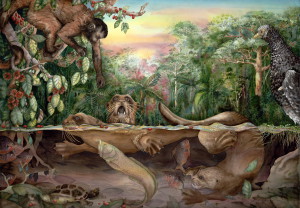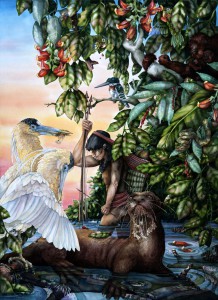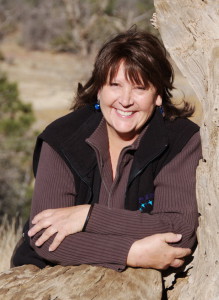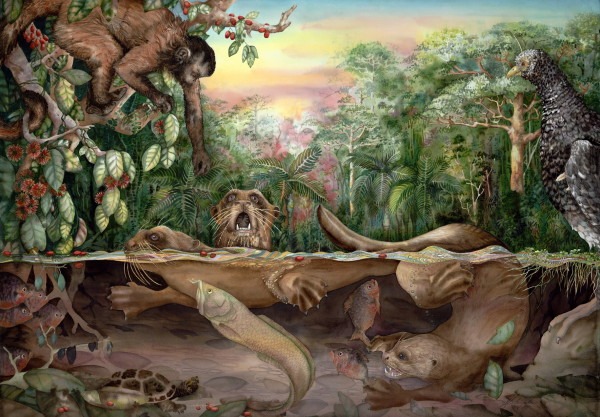Early in my career, I loved the mechanics of printmaking, and drawing and I began to create visual narratives about my world. My desire was to communicate these thoughts through drawings that represented the impact of humanity. I was resolving on a larger scale, thoughts about the mechanics of religion, politics, community, government, corporations etc. I drew situations that represented where an individual is linked by inter-relationships to the greater humanity of the world. How would I ‘negotiate’ myself, in the ‘big’ plan? It seemed being a steward of the planet was an expected responsibility, so I was conscious of what I consumed. I was part of the collective we who ‘fit’ into the planet as ‘citizens of humanity’ riding through space on the rare blue water planet.
We all became aware
of the capacity society
had to annihilate and
change destinies.
As a baby boomer, born after World War II, my formative consciousness happened during the 60’s and 70’s. Civilization was beginning to re-evaluate human impact on all levels. My brother went off to Korea and Vietnam, and I college. We all became aware of the capacity society had to annihilate and change destinies. I thought seriously about the cost of my existence. What my existence contributed to the world, and became vividly aware of what I took out of it and what I needed to put back into it. Recognizing that each of us born, not free from responsibility, but with a debt depending on our consumption of resources. That had a huge effect on me as an artist, as I recognized the fragility of the human race. My artwork reflected the psychology of population and consumption, with images of people, cars, and big industry despoiling nature and cultures. I felt like a prophet of that time. Creating intertwined symbolic images representing the social dogma of civilization to nature.
As an Art/Life-Science major in college, I explored these relationships through a lens of understanding nature’s network. I visualized how I, the artist, fit into this scheme. Having to make a living wage, I took an opportunity to improve the internal combustion engine and help build test equipment that measured air pollution. It became clear to me, humanity needed nature more than nature needed us. An artist, in a male dominated field of manufacturing, and one who always thought out of the box, my influence became an ‘environmental conscience’, in our for profit company. Together we sought to set a standard of excellence by example in business and our personal endeavors. Education and inspiration became the forefront for our business, and my artwork. We made nationally televised nature documentaries that informed others of the diversity of nature, especially rainforests. That became our avocation for several decades and helped preserve hundreds of square miles of forest and species because of those films.
It seemed at the time, our personal existence, and the business we had built and operated for 35 years, could balance out every day excesses. We lived as if some of the negative results of human impact on the environment would be minimized. Someone made these important choices about humanity’s future, and it was ‘us’. Threats to life sustaining elements such as clean water, clean air, plant diversity, and self-sustaining ecosystems compromised by human action demanded our advocacy and seeped into business goals and my artwork.

Unfortunately, as we looked with satellites at the blue planet from space, we soon learned, those negatively affecting it rarely are able to fix the imbalanced equation. The interlocking of eco-systems though part of our social consciousness, remained unknown by the mass of humanity who only look for resources to support daily existence. Mega corporations are not philosophically invested to improve the current quality of life, but only to improve their bank account. Our small manufacturing business and my visual art could hardly be significant.
Now, at 66, it is abundantly clear in the 21st century, priorities have shifted, and the objective forgotten by those gifted with the, political knowledge, power and financial privilege, to affect these checks and balances, remain blindly short sighted. Social and Global economics has evolved and strangely altered every resource into a commodity with a price. Systems constructed that calculate with only profitability and short-term gain with a ‘flawed’ equation. It is immensely dis-heartening.
We ‘nibble’ at
the edges of
intact ecosystems
The human ego would like us to believe that technology will solve all that we do not yet understand. Resources can always be ‘managed or created’. The painting Trouble in Paradise, asks this important question, “How do giant otters and monkey communities communicate or protect their food source, or livelihood, when it is always ‘up for grabs’?” In long-evolved environments that contain uniquely evolved life forms, humans are still setting fires on the horizon. We ‘nibble’ at the edges of intact ecosystems, and they get smaller and less able to sustain themselves because of our lack of restraint and intrusion. Where do these millions of creatures, many still unknown to science, get reciprocity? Ironic only human compassion protects life’s astounding diversity. Some days I wonder what life would be like if dinosaurs still roamed the earth and picked us off while coming out of the grocery store.

Today, people naively assume that future science, technology, and engineering, makes chopping down the rainforest for a table or a steak or fouling the ocean can be corrected later when science catches up with consumption. Human accountability runs unchecked like a credit card limit always being increased and never coming due. The concept of the ad; ’what happens in Vegas, never reeeaaally just stays in Vegas.’ We find plastic in every environment on the planet. Our geological layer will be identified by plastic particles. Wasting it now seems to me as an international crime against humanity and nature.
If we still believe that all
is ours for the taking,
we fail to understand
what truly matters.
These are the questions I want my paintings to explore and stimulate in the minds of those who view them. In this way, they can be a narrative that leads the viewer on a journey of evaluation, which ultimately has the power to change the choice we make in our personal existence. That goes back to the debt we owe for our existence. Diversity vs. Destruction shows the edge of mindless destruction. Who pays the ultimate cost of this demise and where is the point of no return? Human societies are hardly able to mobilize and take action in a natural disaster, let alone the scale of climate change. If we still believe that all is ours for the taking, we fail to understand what truly matters. Nature can wipe us out in a second.
We protect what we know and save what we love. How can self-sustaining ecosystems, convince humanity not to invade and devastate it? Does wildlife ever retain an edge if humans are in charge? As new human generations get more ‘divorced’ from nature, and seduced by gadgets, the value, joy, and preciousness of co-existing with nature will vanish, along with the desire to protect it. I want my paintings to make people stop and think; “What’s going on here?” Look at the intricate uniqueness of nature in a new way. Keep demanding the right results for a collective future, and step into the roles we each must play in preserving a sustainable interconnected planet.
The works by Mary Helsaple featured in this post are currently on display in the traveling museum exhibition Environmental Impact.
 Mary Helsaple is an artist, retired business owner, and retired member of the Board of Directors of several Colorado non-profit art organizations, notably: the Imagination Celebration in Colorado Springs. She is also an award winning Nature Photographer, Nature filmmaker, Speaker & Writer/ Illustrator. She has been actively involved with the Creative Arts, Community, and Nature Conservation organization in Colorado and Arizona and exhibited nationwide since 1976. Helsaple has a BFA in Fine Arts and Minor in Life sciences from San Francisco State University, CA.
Mary Helsaple is an artist, retired business owner, and retired member of the Board of Directors of several Colorado non-profit art organizations, notably: the Imagination Celebration in Colorado Springs. She is also an award winning Nature Photographer, Nature filmmaker, Speaker & Writer/ Illustrator. She has been actively involved with the Creative Arts, Community, and Nature Conservation organization in Colorado and Arizona and exhibited nationwide since 1976. Helsaple has a BFA in Fine Arts and Minor in Life sciences from San Francisco State University, CA.
This post is part of the MAHB’s Arts Community space –an open space for MAHB members to share, discuss, and connect with artwork processes and products pushing for change. Please visit the MAHB Arts Community to share and reflect on how art can promote critical changes in behavior and systems and contact Erika with any questions or suggestions you have regarding the new space.
MAHB-UTS Blogs are a joint venture between the University of Technology Sydney and the Millennium Alliance for Humanity and the Biosphere. Questions should be directed to joan@mahbonline.org
MAHB Blog: https://mahb.stanford.edu/blog/visual-narratives/
The views and opinions expressed through the MAHB Website are those of the contributing authors and do not necessarily reflect an official position of the MAHB. The MAHB aims to share a range of perspectives and welcomes the discussions that they prompt.
